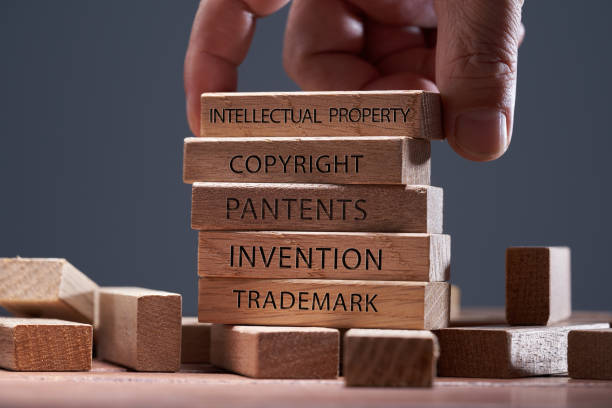Introduction
In the ever-evolving landscape of intellectual property (IP) law, staying ahead of the curve is essential for businesses seeking to protect their innovative assets. With the advent of Artificial Intelligence (AI), a new era has dawned upon the legal domain, bringing about transformative changes in the way intellectual property strategies are conceived and executed. This blog explores the intersection of AI and IP law, delving into the profound impact of AI on legal outcomes and the strategic shifts it necessitates.

The AI Revolution in Intellectual Property
The integration of Artificial Intelligence (AI) into the realm of intellectual property (IP) has ushered in a transformative era, revolutionizing the way businesses approach the protection, management, and valuation of their innovative assets. This AI revolution brings forth a multitude of advancements, fundamentally altering traditional processes and offering unprecedented opportunities for efficiency and strategic decision-making.
1. Automating Prior Art Searches
Traditionally, the process of conducting prior art searches for patent applications has been a time-consuming and resource-intensive task. The advent of AI has revolutionized this aspect of intellectual property by automating and streamlining the prior art search process. Natural Language Processing (NLP) algorithms enable AI systems to analyze vast databases, scientific literature, and patent repositories, swiftly identifying relevant prior art. This not only accelerates the patent application process but also enhances the accuracy of identifying existing technologies.
2. Predictive Analytics for Patent Valuation
AI’s predictive analytics capabilities have become a cornerstone in assessing the value of patents. By analyzing historical patent data, market trends, and technological developments, AI algorithms can provide insights into the potential value of a patent. This enables businesses to make informed decisions regarding portfolio management, licensing agreements, and overall IP strategy. Predictive analytics mitigates uncertainties, allowing organizations to allocate resources more effectively based on the anticipated value of their intellectual property.
3. Enhanced Contract Review and Drafting
AI’s impact extends to the legal aspects of IP management, particularly in contract review and drafting. AI-powered tools equipped with machine learning algorithms can expedite the review of licensing agreements, ensuring compliance with IP laws and industry standards. These tools not only enhance the efficiency of legal teams but also reduce the risk of oversights or errors in contractual language, ultimately minimizing the potential for legal disputes.
4. Trademark Protection and Monitoring
The AI revolution has greatly strengthened trademark protection efforts. Automated systems, employing machine learning algorithms, can monitor digital platforms, social media, and marketplaces to swiftly detect potential trademark infringements, counterfeit products, and unauthorized usage of intellectual property. This proactive approach to monitoring safeguards brand integrity and allows for rapid response to potential threats.
5. Strategic Portfolio Management
AI’s analytical capabilities empower organizations to strategically manage their IP portfolios. Machine learning algorithms can analyze vast amounts of data to identify trends, assess the competitive landscape, and recommend optimal portfolio adjustments. This data-driven approach ensures that businesses can align their IP strategies with market dynamics, emerging technologies, and evolving consumer preferences.
AI in Trademark Protection
The integration of Artificial Intelligence (AI) into trademark protection has revolutionized the way businesses safeguard their brand identities and intellectual property. AI technologies bring unparalleled efficiency and accuracy to the monitoring and enforcement of trademarks, providing companies with powerful tools to combat infringements, counterfeits, and unauthorized usage across diverse digital platforms.
1. Automated Trademark Monitoring
AI-powered systems excel in automating the monitoring of trademarks across the vast expanse of the internet. These systems employ machine learning algorithms to scan websites, social media platforms, e-commerce sites, and other digital spaces, swiftly identifying potential infringements. Automated trademark monitoring ensures that businesses can proactively address unauthorized use or misuse of their brand elements.
2. Image Recognition for Brand Protection
Image recognition technology, a subset of AI, plays a crucial role in brand protection. AI algorithms can analyze images and visual content across online platforms, detecting instances where logos, product packaging, or other brand elements are used without authorization. This capability is particularly valuable in identifying visual trademark infringements that may go unnoticed through traditional text-based searches.
3. Sentiment Analysis for Brand Image Monitoring
AI-driven sentiment analysis tools contribute to brand protection by gauging public sentiment and perception. These tools analyze social media posts, reviews, and online discussions to assess how the brand is perceived by the public. This proactive approach allows companies to identify and address potential threats to their brand reputation, enabling timely responses to emerging issues.
4. Customized Watchlists and Alerts
AI in trademark protection facilitates the creation of customized watchlists tailored to the specific needs and characteristics of a brand. Automated alerts notify businesses in real-time when potential infringements are detected. This proactive monitoring and immediate notification enable rapid responses, reducing the risk of prolonged unauthorized use or dilution of the brand.
5. Global Trademark Databases and Linguistic Analysis
AI technologies enable comprehensive searches across global trademark databases, helping businesses identify potential conflicts before entering new markets. Linguistic analysis capabilities within AI systems assist in detecting variations and misspellings of trademarks that may pose a risk. This linguistic scrutiny is particularly valuable in mitigating the risk of brand confusion and dilution.

Overcoming Challenges with AI-Powered IP Strategies
Implement Robust Cybersecurity Measures
To overcome the challenge of data security and privacy concerns associated with AI-powered IP strategies, organizations should prioritize the implementation of robust cybersecurity measures. This includes encryption of sensitive data, regular security audits, and the adoption of secure channels for data transmission. Employing multi-factor authentication and access controls ensures that only authorized personnel can access critical intellectual property information, mitigating the risk of unauthorized breaches.
Adopt Explainable AI (XAI) Techniques
Addressing the legal and ethical challenges related to AI decision-making requires the adoption of Explainable AI (XAI) techniques. By incorporating transparency into AI algorithms, legal professionals can better understand and interpret the reasoning behind AI-generated insights and decisions. This not only enhances the accountability of AI systems but also facilitates human oversight, allowing legal practitioners to identify and rectify any biases that may be present in the algorithms.
Stay Informed and Engage in Continuous Training
The rapid evolution of AI technology demands that legal professionals stay informed about the latest advancements and updates in the field. Continuous training and education programs can equip legal practitioners with the knowledge and skills needed to navigate the complexities of AI-powered IP strategies. By fostering a culture of ongoing learning, organizations can ensure that their legal teams are well-prepared to leverage AI tools effectively and responsibly.
Collaborate with AI Developers and Ethicists
Overcoming challenges in AI-powered IP strategies requires collaboration between legal professionals, AI developers, and ethicists. Legal teams should actively engage with AI developers to ensure that AI systems align with legal standards and ethical considerations. Ethicists can contribute valuable insights into the development of responsible AI algorithms, helping to identify and mitigate potential biases and ethical concerns. This collaborative approach promotes the creation of AI solutions that are not only technically robust but also ethically sound.
Advocate for Clear Legal Frameworks
To address the challenge of evolving legal frameworks, legal professionals should actively advocate for clear and adaptive regulations that encompass the use of AI in intellectual property. Engaging with policymakers and industry stakeholders, legal practitioners can contribute to the development of comprehensive legal frameworks that address emerging issues and provide guidance on the responsible deployment of AI in the context of IP. Proactive involvement in shaping legal standards ensures that the regulatory environment keeps pace with the rapid advancements in AI technology.
By implementing these strategies, organizations can proactively overcome the challenges associated with AI-powered IP strategies, fostering a secure, transparent, and ethically sound integration of AI in the legal domain.
Future Trends and Implications
1. AI-Powered Patent Prosecution
The integration of AI in patent prosecution is expected to revolutionize the way patent applications are examined and processed. AI tools can assist patent examiners in identifying relevant prior art, accelerating the overall patent granting process.
2. Blockchain and IP Protection
The combination of AI and blockchain technology holds immense potential for enhancing the security and traceability of intellectual property. Blockchain’s decentralized and tamper-resistant nature can be leveraged to create immutable records of IP rights, reducing the risk of fraud and unauthorized modifications.
3. Global Collaboration and Standardization
As AI becomes an integral part of IP strategies, the need for global collaboration and standardization in AI-related IP laws is becoming increasingly apparent. Collaborative efforts among countries to establish common standards and guidelines can facilitate the effective implementation of AI in intellectual property protection on a global scale.
Conclusion
In conclusion, the marriage of AI and intellectual property law marks a transformative juncture, offering unprecedented opportunities for businesses to optimize their IP strategies. From expediting patent processes to fortifying trademark protection, AI is reshaping the legal landscape in profound ways. However, as with any technological advancement, challenges and ethical considerations must be addressed to ensure a responsible and equitable integration of AI in intellectual property management. As we navigate this dynamic intersection of law and technology, one thing is clear – the synergy between AI and IP is a potent force that will continue to redefine legal outcomes in the years to come.

Leave a Reply